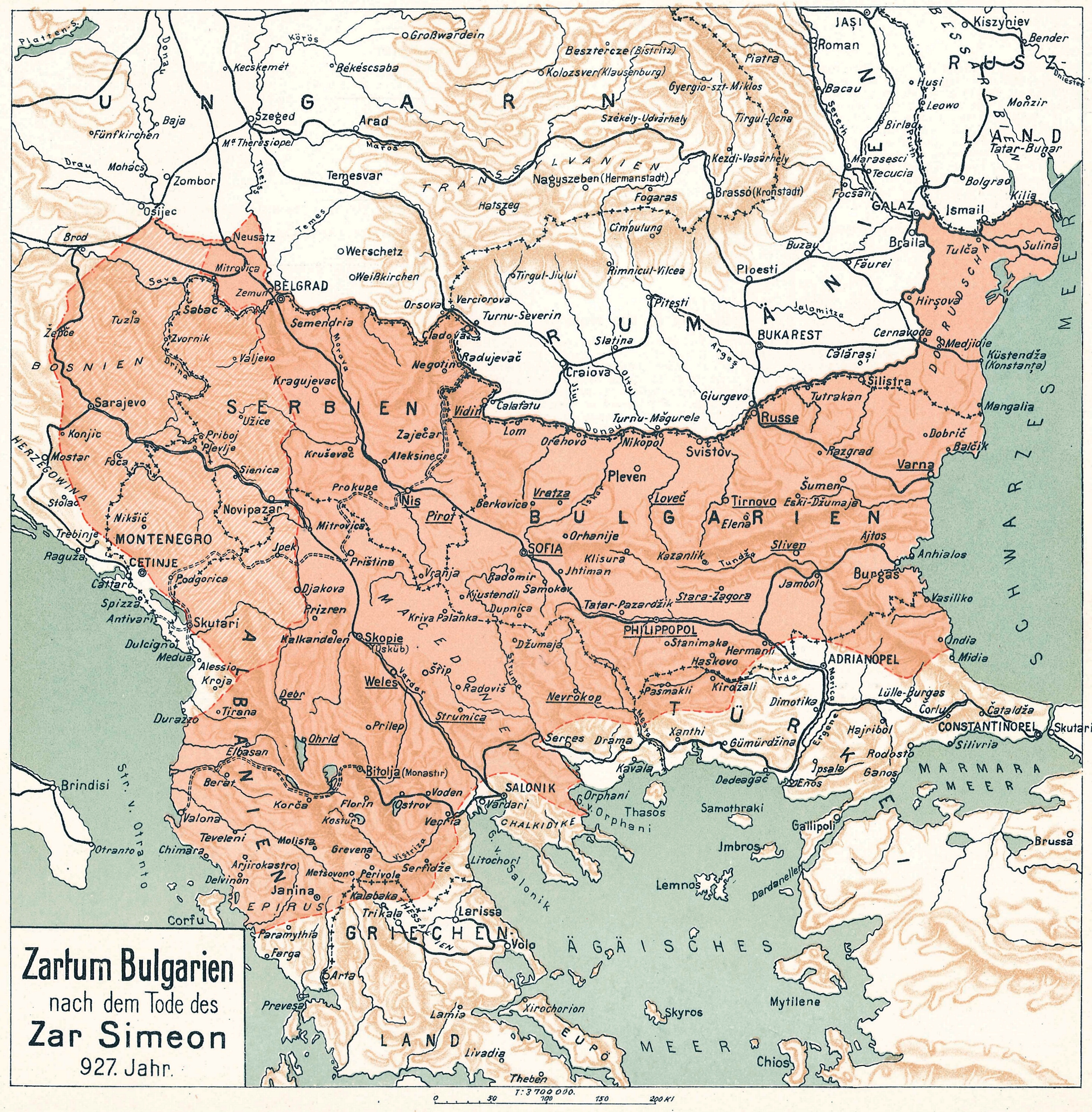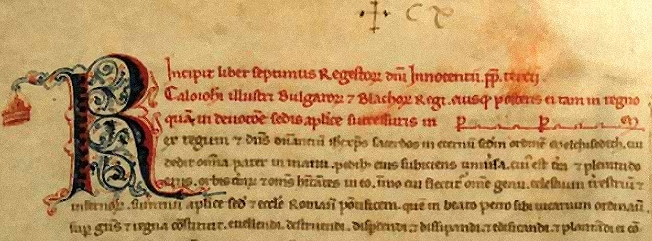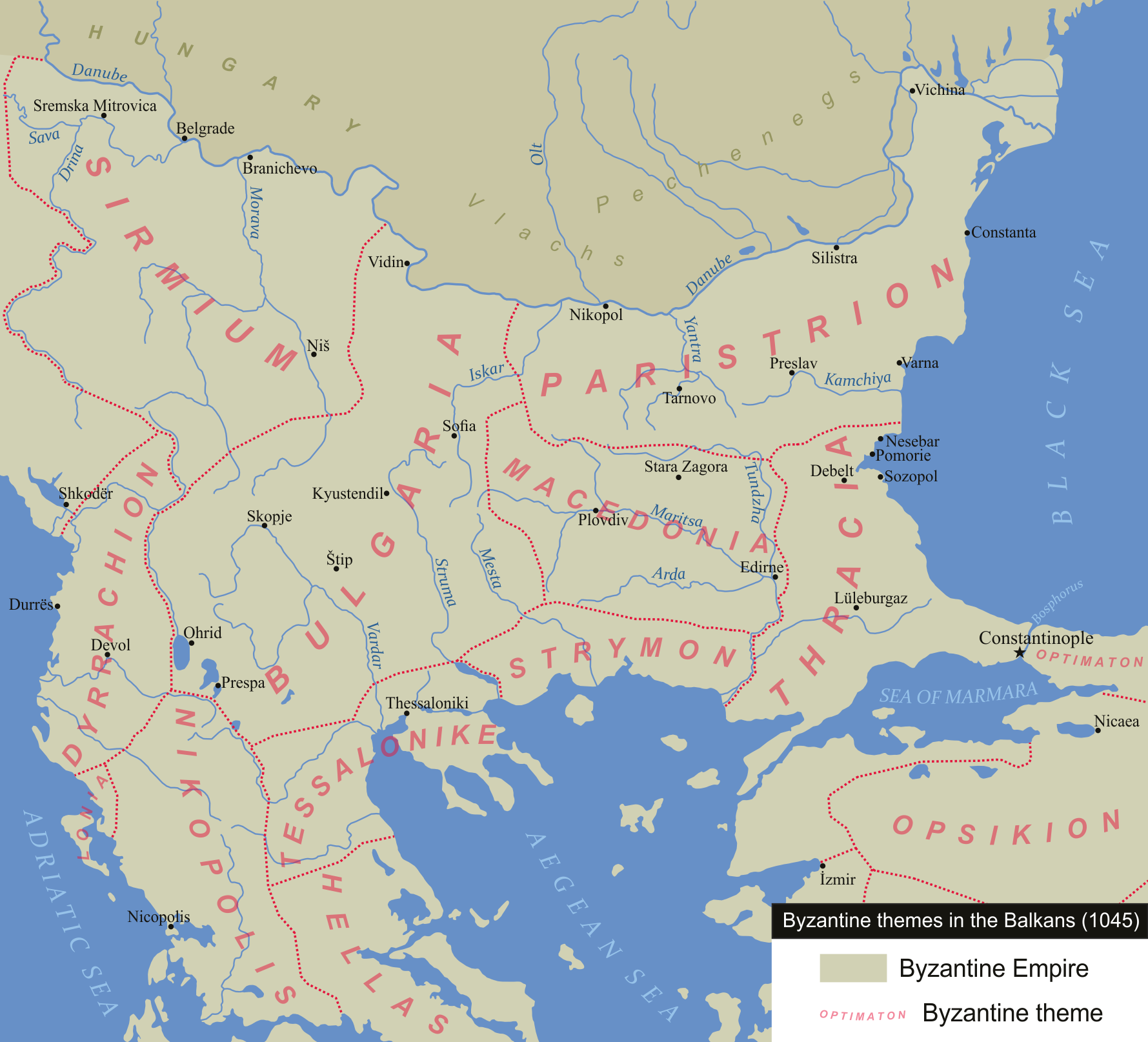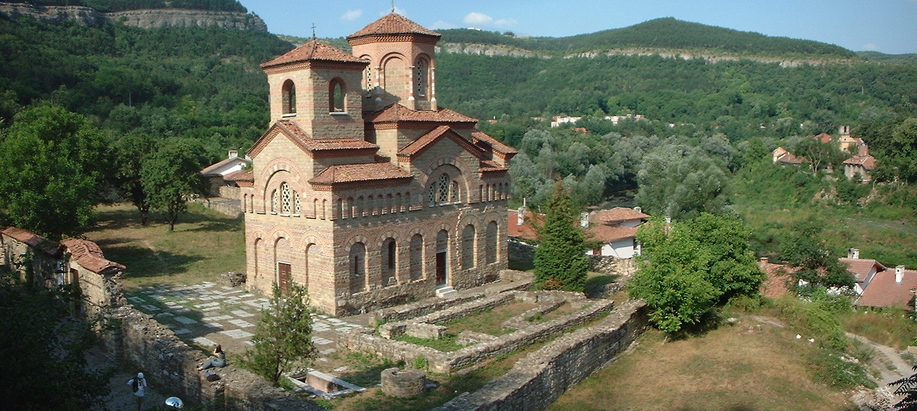|
Byzantine–Bulgarian Wars
The Byzantine–Bulgarian wars were a series of conflicts fought between the Byzantine Empire and Bulgaria which began after the Bulgars conquered parts of the Balkan peninsula after 680 AD. The Byzantine and First Bulgarian Empire continued to clash over the next century with variable success, until the Bulgarians, led by Krum of Bulgaria, Krum, inflicted a series of crushing defeats on the Byzantines. After Krum died in 814, his son Omurtag negotiated a thirty-year peace treaty. Simeon I of Bulgaria, Simeon I had multiple successful campaigns against the Byzantines during his rule from 893 to 927. His son Peter I of Bulgaria, Peter I negotiated another long-lasting peace treaty. His rule was followed by a period of decline of the Bulgarian state. In 971 John I Tzimiskes, the Byzantine emperor, subjugated much of the weakening Bulgarian Empire by defeating Boris II of Bulgaria, Boris II and capturing Preslav, the Bulgarian capital. Samuel of Bulgaria, Samuel managed to stabiliz ... [...More Info...] [...Related Items...] OR: [Wikipedia] [Google] [Baidu] |
Battle Of Achelous (917)
The Battle of Achelous or Acheloos (, ), also known as the Battle of Anchialus,Stephenson (2004), p. 23 took place on 20 August 917, on the Achelous river near the Bulgarian Black Sea coast, close to the fortress Tuthom (modern Pomorie) between Bulgarian and Byzantine forces. The Bulgarians obtained a decisive victory which not only secured the previous successes of Simeon I, but made him ''de facto'' ruler of the whole Balkan Peninsula, excluding the well-protected Byzantine capital Constantinople and the Peloponnese. The battle, which was one of the biggest and bloodiest battles of the European Middle Ages, was one of the worst disasters ever to befall a Byzantine army, and conversely one of the greatest military successes of Bulgaria.Haldon (2008), p. 92 Among the most significant consequences was the official recognition of the imperial title of the Bulgarian monarchs, and the consequent affirmation of Bulgarian equality vis-à-vis Byzantium. Background After the Bul ... [...More Info...] [...Related Items...] OR: [Wikipedia] [Google] [Baidu] |
Simeon I Of Bulgaria
Simeon I the Great (; ; ) ruled over Bulgaria from 893 to 927,Lalkov, ''Rulers of Bulgaria'', pp. 23–25. during the First Bulgarian Empire. Simeon's successful campaigns against the Byzantines, Magyars and Serbs led Bulgaria to its greatest territorial expansion ever, making it the most powerful state in contemporary Eastern and Southeast Europe. His reign was also a period of unmatched cultural prosperity and enlightenment later deemed the Golden Age of Bulgarian culture. During Simeon's rule, Bulgaria spread over a territory between the Aegean, the Adriatic and the Black seas.Bakalov, ''Istorija na Bǎlgarija'', "Simeon I Veliki". The newly independent Bulgarian Orthodox Church became the first new patriarchate besides the Pentarchy, and Bulgarian Glagolitic and Cyrillic translations of Christian texts spread all over the Slavic world of the time. It was at the Preslav Literary School in the 890s that the Cyrillic alphabet was developed. [...More Info...] [...Related Items...] OR: [Wikipedia] [Google] [Baidu] |
Mitso Asen Of Bulgaria
Mitso Asen (, ''Mico Asen''), not Micho Asen (Мичо Асен, ''Mičo Asen''), in Greek, Μύτζης, ''Mytzēs'', was the tsar of Bulgaria from 1256 until 1257. Reign Mitso Asen ascended the throne by virtue of his marriage to a daughter of Ivan Asen II of Bulgaria by Irene Komnene of Epirus. The name of his wife is nowhere specified; she has been traditionally identified as Maria, but was perhaps more likely Anna/Theodora. The dates of his birth and death are unknown, and his antecedents are unclear, but neither his name (which is found in official contexts and is not the diminutive of "Michael"), nor his career described in the Byzantine sources allow an identification with Michael, the son of the Rus' prince and Hungarian Ban Rostislav Mikhailovich, nor any other member of the house of Chernigov. It is likely that, like his successor Constantine, the son of Tikh, Mitso Asen adopted the name '' Asen'' after his accession to the throne. He proclaimed himself emperor ... [...More Info...] [...Related Items...] OR: [Wikipedia] [Google] [Baidu] |
Michael II Asen
Michael II Asen (; 1239 – December 1256/January 1257) was emperor (tsar) of Bulgaria from 1246 to 1256 or 1257. He was the son of Ivan Asen II and Irene Komnene Doukaina. He succeeded his half-brother, Kaliman I Asen. His mother or other relative must have ruled Bulgaria during his minority. John III Doukas Vatatzes, Emperor of Nicaea, and Michael II of Epirus invaded Bulgaria shortly after Michael's ascension. Vatatzes captured the Bulgarian fortresses along the river Vardar; Michael of Epirus took possession of western Macedonia. In alliance with the Republic of Ragusa, Michael II Asen broke into Serbia in 1254, but he could not occupy Serbian territories. After Vatatzes died, he reconquered most territories lost to Nicea, but Vatatzes's son and successor, Theodore II Laskaris, launched a successful counter-offensive, forcing Michael to sign a peace treaty. Shortly after the treaty, discontented ''boyars'' (noblemen) murdered Michael. Early life Michael was the ... [...More Info...] [...Related Items...] OR: [Wikipedia] [Google] [Baidu] |
Ivan Asen II
Ivan Asen II, also known as John Asen II (, ; 1190s – May/June 1241), was Emperor (Tsar) of Second Bulgarian Empire, Bulgaria from 1218 to 1241. He was still a child when his father Ivan Asen I of Bulgaria, Ivan Asen I one of the founders of the Second Bulgarian Empire was killed in 1196. His supporters tried to secure the throne for him after his uncle, Kaloyan of Bulgaria, Kaloyan, was murdered in 1207, but Kaloyan's other nephew, Boril of Bulgaria, Boril, overcame them. Ivan Asen fled from Bulgaria and settled in the List of tribes and states in Belarus, Russia and Ukraine#Council of Liubech and after (1097–1237), Rus' principalities. Boril could never strengthen his rule which enabled Ivan Asen to muster an army and return to Bulgaria. He captured Veliko Tarnovo, Tarnovo and blinded Boril in 1218. Initially, he supported the full communion of the Bulgarian Orthodox Church, Bulgarian Church with the Papacy and concluded alliances with the neighboring Catholic powers, Kingd ... [...More Info...] [...Related Items...] OR: [Wikipedia] [Google] [Baidu] |
Kaloyan Of Bulgaria
Kaloyan or Kalojan, also known as Ivan I, Ioannitsa or Johannitsa (; 1170 – October 1207), the Roman Slayer, was emperor or tsar of Second Bulgarian Empire, Bulgaria from 1196 to 1207. He was the younger brother of Peter II of Bulgaria, Theodor and Ivan Asen I of Bulgaria, Asen, who led the Uprising of Asen and Peter, anti-Byzantine uprising of the Bulgarians and Vlachs in 1185. The uprising ended with the restoration of Second Bulgarian Empire, Bulgaria as an independent state. He spent a few years as a hostage in Constantinople in the late 1180s. Theodor, crowned Emperor Peter II, made him his co-ruler after Asen was murdered in 1196. A year later, Peter was also murdered, and Kaloyan became the sole ruler of Bulgaria. After the successful Siege of Varna (1201), siege of Varna in 1201 against the Byzantine Empire, the defenders and governors of the city were tied and thrown into the moat of the fortress walls and covered with dirt by the Bulgarians. After they were buried a ... [...More Info...] [...Related Items...] OR: [Wikipedia] [Google] [Baidu] |
Ivan Asen I
Ivan Asen I, also known as Asen I or John Asen I (; died in 1196), was emperor or tsar of Bulgaria from 1187/1188 to 1196 as co-ruler with his elder brother, Peter II. Hailing from the Byzantine theme of Paristrion, his exact place and date of birth are unknown. Most contemporaneous chronicles describe Asen and his brothers, Theodor (Peter) and Kaloyan, as Vlachs but they were probably of mixed Bulgarian, Cuman and Vlach ancestry. In 1185, Asen and Theodor went to see the Byzantine Emperor Isaac II Angelos in Thrace to demand an estate in the Balkan Mountains. After the Emperor refused and humiliated them, the brothers persuaded their Bulgarian and Vlach compatriots to rise up against the Byzantine Empire. Before the end of the year, Theodor was crowned Emperor of Bulgaria, taking the name Peter. After Isaac II defeated them in early 1186, Asen and Peter fled north over the Danube but returned in the autumn, accompanied by Cuman reinforcements. They captured Paristrion and ... [...More Info...] [...Related Items...] OR: [Wikipedia] [Google] [Baidu] |
Peter II Of Bulgaria
Peter II, born Theodor, also known as Theodor-Peter (; died in 1197), was the first emperor or tsar of the restored Bulgarian Empire from 1185 to 1197. He hails from the Byzantine theme of Paristrion, although his exact place and date of birth are unknown. He and his younger brothers, Asen and Kaloyan, were mentioned as Vlachs in most foreign contemporaneous sources but they were probably of a mixed Vlach, Bulgarian, and Cuman origin. In 1185, Theodor and Asen approached the Byzantine Emperor Isaac II Angelos in Thrace, demanding an estate in the Balkan Mountains. After the Emperor refused and humiliated them, they decided to incite a rebellion, taking advantage of the discontent that a new tax had caused among the Bulgarians and Vlachs. To convince their compatriots to join them, they had native prophets declare that Saint Demetrius of Thessalonica had abandoned the Romans in favour of the Bulgarians and Vlachs. Before the end of the year, Theodor was crowned Emperor of ... [...More Info...] [...Related Items...] OR: [Wikipedia] [Google] [Baidu] |
Constantine Bodin
Constantine Bodin ( Bulgarian and , ''Konstantin Bodin''; 1072–1101) was a medieval king and the ruler of Duklja, the most powerful Serbian principality of the time, from 1081 to 1101, succeeding his father, Mihailo Vojislavljević ( 1046–1081). Born in peaceful times, when the South Slavs were subjects of the Byzantine Empire, his father was in 1072 approached by Bulgarian nobility, who sought aid in their revolt against the Byzantines. Mihailo sent them Bodin, who was crowned Bulgarian tsar under the name Peter (, ''Petŭr''); he is therefore sometimes enumerated as Peter III (Петър ІІІ) as ''tsar''. Bodin joined the short-lived revolt, being captured the following year after initial success. He was freed in 1078, and upon the death of his father in 1081 he succeeded to the throne of Dioclea. Having renewed his acknowledgement of Byzantine overlordship, he soon sided with their enemies, the Normans, which resulted in a Byzantine invasion and his capture. ... [...More Info...] [...Related Items...] OR: [Wikipedia] [Google] [Baidu] |
Petar Delyan
Petar Delyan (reigned 1040–1041) (; Greek: Πέτρος Δελεάνος), sometimes enumerated as Petar II, (Петър II) was the leader of a major Bulgarian uprising against Byzantine rule in the Theme of Bulgaria during the summer of 1040. He was proclaimed Tsar of Bulgaria, as Samuel's grandson in Belgrade, then in the theme of Bulgaria. His original name may have been simply ''Delyan'', in which case he assumed the name Petar II upon accession, commemorating the sainted Emperor Petar I (Petăr I), who had died in 970. The exact year of his birth cannot be ascertained with certainty, but it is believed to have taken place during the early 11th century, likely between 1000 and 1014. Similarly, the year of his death is estimated to be 1041. Origin His origin is not clear. He claimed that he was son of Emperor Gavril Radomir and grandson of Samuel of Bulgaria, but he could also be a local who became leader of the uprising and claimed to be Samuel's grandson to justify ... [...More Info...] [...Related Items...] OR: [Wikipedia] [Google] [Baidu] |
Ivan Vladislav Of Bulgaria
Ivan Vladislav (; ; died February 1018) served as the emperor (tsar) of the First Bulgarian Empire from approximately August or September 1015 until February 1018. The precise year of his birth remains elusive; he was born at least ten years prior to 987, but likely not much earlier than that. Saved from death by his cousin Gavril Radomir, the Bulgarian Emperor, in 976, Ivan Vladislav murdered him in October 1015 and seized the Bulgarian throne. Due to the desperate situation of the country following the decades-long war with the Byzantine Empire, and in an attempt to consolidate his position, he tried to negotiate truce with the Byzantine emperor Basil II. After the failure of the negotiations he continued the resistance, attempting unsuccessfully to push the Byzantines back. During his period of rule, Ivan Vladislav tried to strengthen the Bulgarian army, reconstructed many Bulgarian fortresses and even carried out a counter-offensive, but he died at the Battle of Dyrrhachium ... [...More Info...] [...Related Items...] OR: [Wikipedia] [Google] [Baidu] |
Gavril Radomir Of Bulgaria
Gavril Radomir (; ; anglicized as Gabriel Radomir; died 1015) was the Emperor (Tsar) of the First Bulgarian Empire from October 1014 to August or September 1015. He was the son of tsar Samuel (). Biography During his father's reign, his cousin Ivan Vladislav and Ivan's entire family were all sentenced by Samuel to death for treason. Gavril's intervention saved at least his cousin. He is said to have saved his father's life in the disastrous defeat of the Battle of Spercheios, and he was described as a gallant fighter. Around the same time that Emperor Basil II captured the bulk of Samuel's army, Gavril and his forces defeated the army of Theophylact Botaneiates. Having inherited Samuel's war with the Byzantine Empire, Gavril Radomir raided Byzantine territory, reaching as far as Constantinople. However, the Byzantines secured the assistance of Ivan Vladislav, who owed his life to Radomir. Vladislav murdered Radomir while hunting near Ostrovo, and then took the throne for hi ... [...More Info...] [...Related Items...] OR: [Wikipedia] [Google] [Baidu] |








